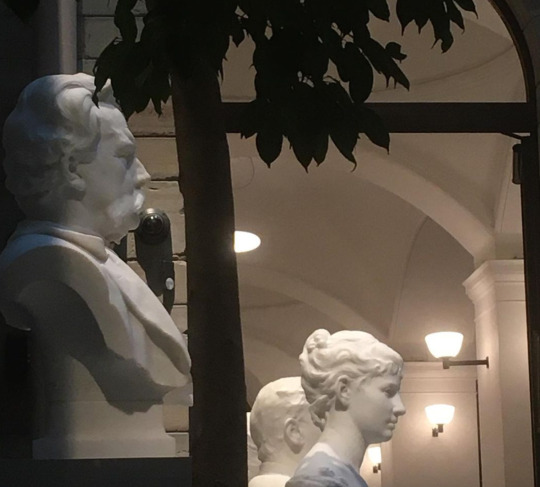Don't wanna be here? Send us removal request.
Photo


“Man kan inte stiga ned två gånger i samma flod.” – Herakleitos Analogt foto, 2021
0 notes
Photo



[FACES]
Have I said it before? I am learning to see. Yes, I am beginning. It’s still going badly. But I intend to make the most of my time.
For example, it never occured to me before how many faces there are. There are multitudes of people, but there are many more faces, because each person has several of them. There are people who wear the same face for years; naturally it wears out, gets dirty, splits at the seams, streches like gloves worn during a long journey. They are thrifty, uncomplicated people; they never change it, never even have it cleaned. It’s good enough, they say, and who can convince them of the contrary? Of course, since they have several faces, you might wonder what they do with the other ones. They keep them in storage. Their children will wear them. But sometimes it also happens that their dogs go out wearing them. And why not? A face is a face.
Other people change faces incredibly fast, put on one after another, and wear them out. At first, they think they have an unlimited supply; but when they are barely fourty years old they come to their last one. There is, to be sure, something tragic about this. They are not accustomed to taking care of faces; their last one is worn through in a week, has holes in it, is in many places as thin as paper, and then, little by little, the lining shows through, the non-face, and they walk around with that on.
But the woman, the woman: she had completely fallen into herself, forward into her hands. It was on the corner of rue Notre-Dame-des-Champs. I began to walk quietly as soon as I saw her. When poor people are thinking, they shouldn’t be disturbed. Perhaps their idea will still occur to them.
The street was too empty; its emptiness had gotten bored and pulled my steps out from under my feet and clattered around in them, all over the street, as if they were wooden clogs. The woman sat up, frightened, she pulled out of herself, too quickly, too violently, so that her face was left in her two hands. I could see it lying there; its hollow form. It cost me an indescribable effort to stay with those two hands, not to look at what had been torn out of them. I shuddered to see a face from the inside, but I was much more afraid of that bared flayed head waiting there, faceless.
Rainer Maria Rilke
(translation by Stephen Mitchell)
0 notes
Video
tumblr
En video från två år sedan, filmad i södra Frankrike.
0 notes
Text
Sur l’absurde et le moderne dans L’Étranger
En text jag skrev om L’Étranger av Camus på min franskakurs som jag fick lust att dela med mig av.
Voici un bref texte que j’ai écrit sur L’Étranger...
S’il y a un thème principal dans L’étranger, et dans l’œuvre d’Albert Camus en général, c’est probablement la notion de l’absurde. Il s’agit de la recherche incessante de l’être humain de trouver un sens à son existence, et la frustration face à l’absence des réponses claires à cette question. Un fossé se forme autour de l’individu qui le sépare du monde extérieur et du monde commun. L’absurde, c’est peut-être d’une manière l’expérience curieuse du monde moderne, de l’aliénation où on est coupé de tout : de la vie contemporaine dans laquelle on se trouve, de l’avenir, mais avant tout de l’histoire, de l’héritage culturel et spirituel, du sens et de la cohérence d’un monde ancien qui n’existe plus.
Celui qui vit cette absurdité, c’est l’étranger. L’étranger, qui est, évidemment, étranger à tout, spectateur ou « non-participant » à tous les grands événements de sa vie, comme c’est le cas de Meursault : l’enterrement de sa mère, ses relations intimes, un crime fatal, son propre procès et la peine qui suit.
Le célèbre incipit : « Aujourd’hui, maman est morte. Ou peut-être hier, je ne sais pas », manifeste l’esprit du roman avec clarté. À l’enterrement qui suit, Meursault rencontre les amis de sa mère, et après il pense : « J’avais peine à croire à leur réalité », ce qui donne aussi un sentiment emblématique du livre : l’étranger, c’est aussi celui qui a perdu la sensation de la réalité, celui qui ne peut plus se fier complètement au témoignage des sens. De cette manière elle est peut-être perdue l’importance de la vie d’une autre personne, ce qui aura des conséquences irrévocables pour Meursault.
Ses actions ont une qualité de l’arbitraire. Pourquoi fait-il ce qu’il fait ? Il ne peut pas y répondre. « Pourquoi pas ? » est le plus proche d’une réponse qu’il trouve. Il l’a fait, comme il dit, « pour faire quelque chose ». C’est une existence inversée. Manquant des raisons, il cherche des « non-raisons », comme quand il dit : « je me suis appliqué à contenter Raymond parce que je n’avais pas de raison de ne pas le contenter ». Le hasard, avant tout, guide ses actions. Même à la question de savoir pourquoi il a fait le choix apparemment actif de meurtre, il ne trouve aucune réponse compréhensible. Le cours des événements a l’air accidentel, « comme si les chemins familiers tracés dans le ciel d’été pouvaient mener aussi bien aux prisons qu’aux sommeils innocents ». Mais Meursault n’est pas innocent. Bien qu’il s’en remette aux caprices du sort, au refus de toute responsabilité, le refus des choix est également un choix, ce qui a toutefois des conséquences.
Ainsi Meursault devient et demeure un étranger. Voilà l’aliénation complète : pas seulement au monde et aux autres, mais aussi à lui-même et ses propres actions, et finalement sa propre chute. À travers d’un refus constant, d’une critique et d’une séparation impénétrable, qui fait de l’incapacité une vertu, il devient le personnage emblématique d’une époque absurde.

Comme si les chemins familiers tracés dans le ciel d’été pouvaient mener aussi bien aux prisons qu’aux sommeils innocents.
Albert Camus, L’Étranger
4 notes
·
View notes
Photo


“Sverige är ett av de egnaste och vemodigaste länder på jorden. Det är genomsyrat av folksagetankar. I detta land ligger en del undangömda näckrossållade sjöar som bara grubbla sagor, bubbla förhoppningar.” Harry Martinson, Nässlorna Blomma
Analogt foto
2019
1 note
·
View note















